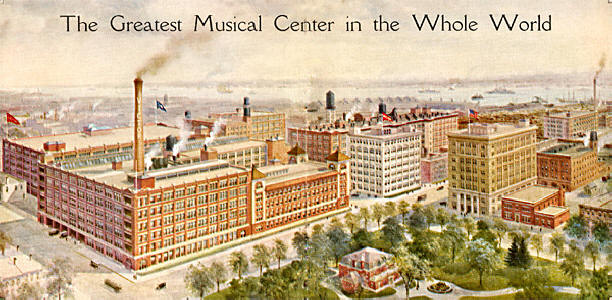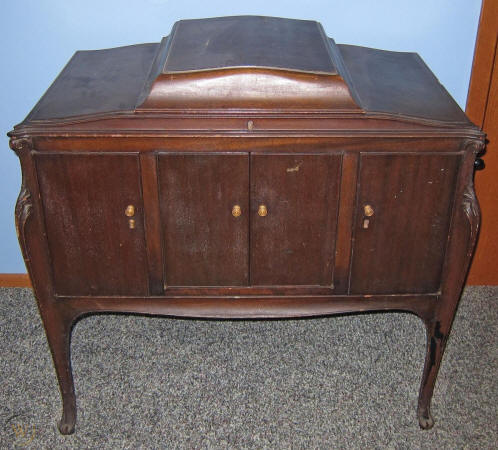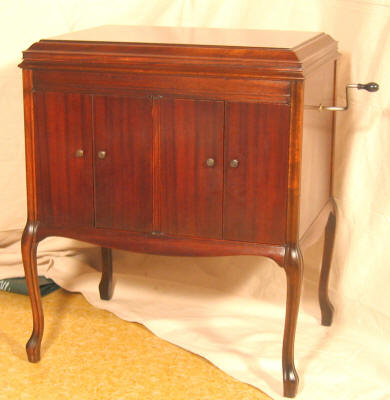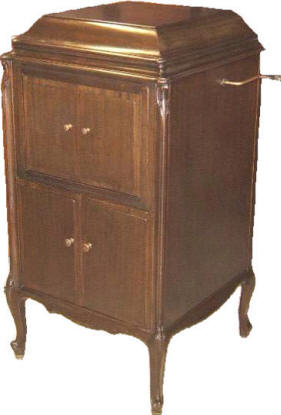The Victor-Victrola Page

Victor's Overproduction Problem and the Financial Crisis of
1924-1925
Paul C. Edie
December 7, 2020
 The
years immediately prior to America's involvement in World War One were
the most profitable in the history of the Victor Talking Machine Company. Victor was
one of the most successful and high-growth companies in the country at that
time. The demand for Victrolas in all price ranges was nothing short of
incredible, and far exceeded what Eldridge Johnson could have ever imagined
when he formed the company back in 1901. Customer interest in Victor
products was high all year long, but during the Christmas Season, the
factory had to run continuously to keep-up with the demand. Special trains were
scheduled for delivery to assure that dealers would have enough stock on-hand.
Exponential growth had become the norm for management; 1915, 1916 and 1917 proved them
right by shattering year-over-year production records. Sales volumes were well over 1/2
million machines by 1917, and was like nothing the company had ever
experienced. Even at those frenzied production levels, customer demand was
still not being fully met. While there were some strong competitors in the
talking machine business, Victor held many important phonograph design patents, which
precluded others from making affordable phonographs that performed as well
as the Victrola product line. The company also maintained very high
production standards, so that product quality and visual appeal was
outstanding. Within a few years, the enormous complex of plants and office
buildings took-up a huge portion of Camden's waterfront area (left). Victor
undertook massive spending and expansion plans, which paid-off handsomely
via increased production capacity and sales.
The
years immediately prior to America's involvement in World War One were
the most profitable in the history of the Victor Talking Machine Company. Victor was
one of the most successful and high-growth companies in the country at that
time. The demand for Victrolas in all price ranges was nothing short of
incredible, and far exceeded what Eldridge Johnson could have ever imagined
when he formed the company back in 1901. Customer interest in Victor
products was high all year long, but during the Christmas Season, the
factory had to run continuously to keep-up with the demand. Special trains were
scheduled for delivery to assure that dealers would have enough stock on-hand.
Exponential growth had become the norm for management; 1915, 1916 and 1917 proved them
right by shattering year-over-year production records. Sales volumes were well over 1/2
million machines by 1917, and was like nothing the company had ever
experienced. Even at those frenzied production levels, customer demand was
still not being fully met. While there were some strong competitors in the
talking machine business, Victor held many important phonograph design patents, which
precluded others from making affordable phonographs that performed as well
as the Victrola product line. The company also maintained very high
production standards, so that product quality and visual appeal was
outstanding. Within a few years, the enormous complex of plants and office
buildings took-up a huge portion of Camden's waterfront area (left). Victor
undertook massive spending and expansion plans, which paid-off handsomely
via increased production capacity and sales.
But by the end of 1917, major changes were fully underway; the USA was fully involved in World War One. The entire country had geared-up to support the war effort, which also meant that Victor had re-tooled their production lines to make armaments such as gun stocks and biplane wings. As was expected, phonograph production dropped significantly, but the company remained profitable via lucrative government contracts. When the war ended in November 1918, customers found few Victrolas available for sale at their local dealer; this was the case for many consumer products immediately after hostilities ceased. Even though the war was over, the impact of manufacturing restrictions had become a reality for shoppers during that holiday season.
Within a year, phonograph production capacity had ramped back up to pre-war levels. The backlogged demand for Victrolas was immense. However, several critical factors began to emerge. Significant wartime inflation had cut into company profits; Victor was forced to raise their retail prices beginning in late 1917, and this trend continued with subsequent price-hikes over the next several years. In addition, many of Victor's patents were expiring, meaning that any upstart company could now produce talking machines that were quite competitive with Victor's designs. And by the spring of 1920, upstart companies were popping-up everywhere. Virtually every city in the country now had a phonograph plant; the products they produced varied from absolute junk to exquisite works of craftsmanship; but in most cases, they could under-cut Victor's prices. This situation prevented Victor from raising their prices any further; so while company expenses continued to rise due to inflation, they could not charge more for their phonographs at the retail level. While production output and sales remained relatively strong, profits were on the decline. By the following year, some of those new competitors were already beginning to drop out of the market; the explosive expansion of the phonograph industry resulted in massive production overcapacity across the country. Supply was beginning to exceed demand.
 Another
alarming trend was also being watched. Phonographs, which in 1915 were still
considered to be desirable luxury items, had now become a basic household
commodity. Public interest in Victor's high-priced machines was waning as buyers were
now favoring cheaper, basic models which now sounded just as good as
the expensive ones (many component designs were shared across the entire
product line). Buying a high-end Victrola as a 'status symbol' had now
become passť. This also impacted Victor's financial
'bottom-line', since the higher-priced machines provided the company
(and dealers) with a significant amount of additional profit. Plus, the
Victrola lineup had become stagnant. Models like the VV-XI and VV-XIV had been around
for over 10 years, and didn't look much different from when they were first
introduced.
Another
alarming trend was also being watched. Phonographs, which in 1915 were still
considered to be desirable luxury items, had now become a basic household
commodity. Public interest in Victor's high-priced machines was waning as buyers were
now favoring cheaper, basic models which now sounded just as good as
the expensive ones (many component designs were shared across the entire
product line). Buying a high-end Victrola as a 'status symbol' had now
become passť. This also impacted Victor's financial
'bottom-line', since the higher-priced machines provided the company
(and dealers) with a significant amount of additional profit. Plus, the
Victrola lineup had become stagnant. Models like the VV-XI and VV-XIV had been around
for over 10 years, and didn't look much different from when they were first
introduced.
Beginning in 1921, Victor made a marketing move
in an attempt to update their product image. The old Roman Numeral model
designations were replaced with conventional Arabic Numbers, and a variety of
new designs were gradually added to the product mix to give their stale
Victrola designs a broader appeal; this marketing move also allowed Victor
to quietly increase profits by reducing product content (size and/or
features) on the newer products without increasing retail prices. But the growing popularity of 'lowboy' flat-top phonograph consoles,
introduced by several of Victor's competitors, was beginning to take a
signficant toll on sales. Victor had claimed for many years that their
'upright' cabinet
designs were the only scientifically-acceptable configuration for excellent
audio reproduction, but their product planners finally yielded to customer
demand and produced a console-style machine in the summer of 1921.
Unfortunately,
Victor added its own design elements to these machines, which included a
domed lid (irreverently nicknamed the 'hump-top') as seen on the VV-300
(left); this was similar to the lid used on their upright machines for many
years prior. Initially, there was considerable buyer interest in these new
Victrolas, but the fact that the sloped surfaces of the cabinet prohibited
the placement of any items on top eventually became a liability for these
models. Plus, they still didn't look like modern furniture as compared to
the sleek consoles produced by other manufacturers. By the time the company
realized that the hump-top design was not going to catch-on with the public,
they had already started production of a full-lineup of these designs across
all price ranges. Victor had to shift gears quickly, and in late 1922,
the company announced a new series of flat-top consoles such as the
VV-210 (right). But by that time, they had already made tens of thousands of
slow-selling hump-top machines, many of which were being stored at the
plant.
But the growing popularity of 'lowboy' flat-top phonograph consoles,
introduced by several of Victor's competitors, was beginning to take a
signficant toll on sales. Victor had claimed for many years that their
'upright' cabinet
designs were the only scientifically-acceptable configuration for excellent
audio reproduction, but their product planners finally yielded to customer
demand and produced a console-style machine in the summer of 1921.
Unfortunately,
Victor added its own design elements to these machines, which included a
domed lid (irreverently nicknamed the 'hump-top') as seen on the VV-300
(left); this was similar to the lid used on their upright machines for many
years prior. Initially, there was considerable buyer interest in these new
Victrolas, but the fact that the sloped surfaces of the cabinet prohibited
the placement of any items on top eventually became a liability for these
models. Plus, they still didn't look like modern furniture as compared to
the sleek consoles produced by other manufacturers. By the time the company
realized that the hump-top design was not going to catch-on with the public,
they had already started production of a full-lineup of these designs across
all price ranges. Victor had to shift gears quickly, and in late 1922,
the company announced a new series of flat-top consoles such as the
VV-210 (right). But by that time, they had already made tens of thousands of
slow-selling hump-top machines, many of which were being stored at the
plant.
The flat-top machines sold briskly but the profit margins continued to shrink; this situation was creating a serious cash-crunch for the company. To add to the problem, Victor's leadership team refused to believe that they could not sell every machine that came off the assembly lines. After all, this had been the case for many years beforehand, so any lull in sales or profitability was considered to be a temporary matter. As a result, they could not temper their seemingly endless plans to increase production capacity. To rectify the cash flow situation, Victor made its first public stock offering in October of 1922. It was a resounding success and attracted investors from all over the country. Every penny that was raised from the sale of stock was dumped back into their massive expansion strategy, including the construction of a new record plant in California, major new building additions in Camden, and adventurous business endeavors in Latin America. Management was convinced that the future would become profitable again after Victor outlasted its failing competition and the demand for their machines returned to pre-war levels. But the company's addiction to limitless expansion and unfettered production plans were soon to have serious consequences.
Warning signs were everywhere. By the end of 1922, the vast majority of Victor's 'upstart' competition had evaporated; this was simply because there was not enough profit in the manufacture of phonographs to sustain these smaller companies. The talking machine business was no longer a cash-cow, and there was now far more supply than demand. Plus a new technology had entered the market like a whirlwind; home radio was becoming immensely popular, and upstart radio manufacturers were appearing everywhere. Victor initially felt that radio was a short-lived fad which would fade away, and made no attempt to get on-board with these new products. But the buying public was losing interest in listening to old-fashioned phonographs; they wanted a radio in their home, which offered infinite variety and was much more interesting and engaging. To hedge their bets just in case this 'fad' was something serious, Victor began offering "radio adaptable" Victrolas, providing extra space to mount an aftermarket radio in the cabinet and piggyback the audio output to the Victrola's horn. Needless to say, that concept didn't spur-on very many extra phonograph sales.
Victor again found itself in a very tight cash flow situation the following year. Additional stock was sold, but investors had now become wary of the talking machine business. They had seen the change in the public's buying trends, and were no longer willing to pay a premium for Victor stock. But the plants kept pumping-out Victrolas as if nothing had changed.
To fully understand the situation, one must first understand the relationship between Victor's production system and its gigantic network of distributors and dealers. Victor sold machines directly to distributors who would store them and provide transportation to retailers. Dealers would order machines from the distributors whenever they were needed. So the distribution system served to simplify Victor's ordering and delivering process, and also served as a 'buffer' for the storage of excess inventory. There was a lot of markup in this structure.
Let's look at the breakdown for the sale of the popular Victrola XI, which sold to customers at a retail price of $100.00:
-
Victor's Production Cost: Materials: $10.23 ; Labor $8.63; Overhead and Expense $4.99; for a total manufacturing cost of $23.89
-
Victor sold these to distributors for $45.00 each; meaning the company made a profit of $21.11 on each one produced
-
Low-volume retail dealers paid the distributor $60.00 each, meaning the distributor made $15.00 on each one they handled. Dealers who met a high sales target could buy them for as little as $54.00 each from the distributor.
-
Dealers sold them for $100.00 each, giving the dealer a handsome $40.00 profit.
The problem was that this system did not provide timely sales feedback to the factory production planners. Retail dealers usually held enough inventory to meet their projected sales. Once the dealer had a sufficient number of machines in-stock, he would quit ordering machines from his regional distributor. So the distributors served as a 'buffer' for the storage of large quantities of machines directly from the plant for eventual delivery to their network of retail dealers. When times were good, everyone was demanding that more product be delivered, and the system worked well. However, when sales slowed, the reporting structure did not provide adequate information back to the company for production planning purposes. In the fall of 1923, Victor was still pumping-out machines at the usual frantic rate, but sales at the retail level were sagging. While the company was aware that a potential problem existed, it didn't appreciate the extent of the slowdown, since the distributors continued to take-on thousands of phonographs which were simply being stored-away, waiting for dealers to place orders. Plus, the financial reporting system at Camden logged factory 'profit' based on how many machines were being made, not how many were being sold. So there was an obvious motivation to keep the production lines moving, but this disconnect from reality nearly proved to be fatal.
 By
the spring of 1924, Victor was facing a crisis. Distributors
were bursting at the seams with unsold products, and refused to take-on more
machines. Victor had also fallen into the habit of stockpiling mountains of
new Victrolas at the factory waiting for distributor orders to arrive, still
convinced that Christmas sales would solve the problem. Before long, it
became obvious that shoppers were no longer buying phonographs.
Panic set-in at the plant, and rather than slowing-down production, the
company added some new products to the mix (such as the ungainly VV-107 shown at left), hoping that they would spur sales. But to no avail. The company
had reached the tipping-point and operating cash had run out. Production virtually
ceased within a matter of days, and thousands were laid-off from the plants in the weeks right
before Christmas. Victrolas had become a stale, unwanted commodity, in
part because they had remained unchanged in basic function and performance
for the past 20 years. A series of advanced development projects had already
been initiated to improve phonograph performance, including the licensing of
electric recording (from Western Electric), the creation of a partnership
with RCA to supply radios, as well as some new, technologically-advanced
designs in the area of soundboxes and horns. However, these ideas were many
months away from mass-production and the company was virtually broke. Stock
prices had collapsed from a high of $1,500.00 per share in 1919 to less than
$1.00 per share. Victor was on the brink of insolvency and began looking for
alternative means of making money. This included the production of furniture
and flooring products (see Dark Days in Camden by Robert Baumbach,
The Antique Phonograph, December 2018).
By
the spring of 1924, Victor was facing a crisis. Distributors
were bursting at the seams with unsold products, and refused to take-on more
machines. Victor had also fallen into the habit of stockpiling mountains of
new Victrolas at the factory waiting for distributor orders to arrive, still
convinced that Christmas sales would solve the problem. Before long, it
became obvious that shoppers were no longer buying phonographs.
Panic set-in at the plant, and rather than slowing-down production, the
company added some new products to the mix (such as the ungainly VV-107 shown at left), hoping that they would spur sales. But to no avail. The company
had reached the tipping-point and operating cash had run out. Production virtually
ceased within a matter of days, and thousands were laid-off from the plants in the weeks right
before Christmas. Victrolas had become a stale, unwanted commodity, in
part because they had remained unchanged in basic function and performance
for the past 20 years. A series of advanced development projects had already
been initiated to improve phonograph performance, including the licensing of
electric recording (from Western Electric), the creation of a partnership
with RCA to supply radios, as well as some new, technologically-advanced
designs in the area of soundboxes and horns. However, these ideas were many
months away from mass-production and the company was virtually broke. Stock
prices had collapsed from a high of $1,500.00 per share in 1919 to less than
$1.00 per share. Victor was on the brink of insolvency and began looking for
alternative means of making money. This included the production of furniture
and flooring products (see Dark Days in Camden by Robert Baumbach,
The Antique Phonograph, December 2018).
In the meantime, tens of thousands of unsold machines lay waiting in crates at the plant and at distributors all over the country. The amount of money tied-up in unsold inventory was straining every aspect of the business network; but at the same time everyone knew that there was no longer any demand for old-fashioned talking machines. So plans were made to 'dump' this inventory via a huge 'Half-Price Sale' to be held in the summer. Everyone involved would have to bear the losses; dealers and distributors would have to take 50% losses on all the machines in their inventory, and Victor was obliged to sell them machines for one-half the normal wholesale prices. Otherwise, nothing would ever be sold, and the entire overstock of machines would become a complete loss. The longer they waited, the worse this situation would become. So while the half-price sale was a bitter pill to swallow, it was better than nothing.
Advertising appeared all over the country, and the half-price sale held during the summer of 1925 was a smashing success. In fact, a significant percentage of the Victrolas that were made during 1923 and 1924 were actually sold during the summer sale; this was particularly true for expensive models that had not been faring well in the marketplace for several years prior. The sale continued for the rest of the year; any excess inventory was eventually packed-up and shipped to Latin America where it was dumped on the market at bargain prices. Meanwhile, some advanced new products were gradually being launched, including the Orthophonic and Electrola product lines, which quickly returned the company to solvency.
It is this author's opinion that the vast majority of 'half-price' Victrolas sold in 1925 were given away as Christmas gifts later that year, and that the recipients of these gifts had little or no interest in using an outdated talking machine. Radio and phonograph dealers were offering small discounts if you traded-in your phonograph on a new radio; in many cases, these 'trade-in' machines could not be sold, so they were burned in large public bonfires as an advertising promotion ("burn your old clunker and buy our new radios!"). Today, we have very little appreciation for how mundane the entire Victrola product line had become by 1925; interest had virtually evaporated, and many acoustic phonographs were subsequently trashed rather than wasting space by being stored in the attic or basement. They had become as worthless as audio cassette boom-boxes are to us today, except they took-up a lot more storage space! Victor came out of the crisis as a less profitable operation, but remained solvent and healthy through 1929 when they were ultimately purchased by RCA.
PLEASE CLOSE THIS PAGE TO RETURN TO THE PRODUCT PAGE
